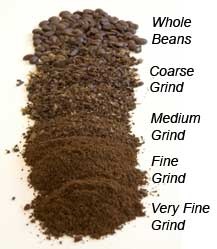Coffee Brewing and Storage
Making a cup of coffee can be quick and simple, a labor-intensive methodical process, and everything in between. Finding your perfect method to achieve your perfect cup can be an adventure. No matter your preparation of choice, always start with fresh coffee and fresh filtered water whenever possible.
Preheating and Blooming
When brewing with methods that require pouring hot water manually into your coffee brewing vessel, always preheat it. You can do this by pouring a small amount of boiling water into the bottom, then discarding the water once your cup or French press is warm.
Blooming is an important and often over-looked step to brewing an exceptional cup of coffee. Freshly ground coffee is full of CO2. As hot water absorbs into coffee grounds, the CO2 molecules are rapidly released. If the coffee is completely immersed in hot water right away, the hot water and CO2 molecules bump into each other, preventing an even extraction. To “bloom” your coffee, start by pouring just enough hot water over your grounds to evenly wet them and let sit for 30 seconds. Your ground coffee should swell to double its size. Frothing is normal!
Ratios, Grinds, and Water Temperature
Finding the perfect balance of coffee to water is all about personal preference. 2 heaping tablespoons of ground coffee per 8 ounces of water is a good place to start. You can always adjust the ratios to your own tastes. The grind of your coffee is less open to interpretation. Different machines and methods require different grind consistencies. Each method description below will have a recommende d grind section. You can grind it yourself at home, or ask your favorite barista to grind it for you! Water temperature plays a more significant role than what might be expected. Too hot and the finish product will have a bitter flavor. Too cool and the coffee will not brew properly. 195 degrees F is ideal for most home-brewing methods.
d grind section. You can grind it yourself at home, or ask your favorite barista to grind it for you! Water temperature plays a more significant role than what might be expected. Too hot and the finish product will have a bitter flavor. Too cool and the coffee will not brew properly. 195 degrees F is ideal for most home-brewing methods.
Storing Coffee
Coffee should always be stored in a cool, dry place within an opaque, airtight container in order to preserve its freshness. Coffee that is over a month old will start to lose its flavor and potency. We do not recommend storing your coffee in the refrigerator, and never in the freezer; coffee has moisture trapped inside, and as that moisture freezes, it damages the cellular structure.
Caffeine and Coffee
Contrary to popular belief, the roast of a coffee does not affect the caffeine content. Darker roasted coffees may have a bolder, richer flavor, but it does not have any more or less caffeine than medium or light roasted coffees. The caffeine content is determined by the coffee bean itself; the soil it was grown in, the exact variety within the species, etc.
Our Decaffeinated coffees are decaffeinated without the use of chemicals, by Swiss Water processing. The coffee beans are submerged in ionized water, drawing the caffeine out of the beans and into the water. This means of processing retains the true flavor of the coffee without exposing it to potentially harmful chemicals.
Brewing Methods:
- French Press: Use a coarse grind. Measure ground coffee into the bottom of your preheated French Press based on the size of the press and recommended coffee measurement. Bloom for 30 seconds then pour the rest of your water into the press. Stir gently with a wooden spoon. Set a timer for 2 1/2 minutes. Replace the lid, but do not press down on the plunger until the 2 ½ minutes is up. Press the plunger down very slowly until you can go no further then pour out all of the brewed coffee; any coffee left in the French press will continue to brew and become bitter.
- Auto Drip: Use a medium grind. Follow the instructions on your machine. Make sure you brew into a preheated carafe or cup.Pour -over: Use a medium-fine grind. Preheat both the pour-over equipment and the cup you are brewing into. Measure out both your coffee and water, and place the grinds in the pour-over cone. Bloom your coffee by pouring boiling water over the grinds in a circular motion until saturated, let sit for 30 seconds. Pour the rest of the water very slowly in a circular motion over the grounds. Allow all of the water to filter through the grounds.
- Turkish: Use the finest grind possible, as this is an unfiltered coffee method. Most of the ground coffee should dissolve in the water. Measure out the ground coffee into the bottom of a preheated cezve (Turkish coffee pot) along with any sugar you would like to include, then fill with cool water and stir until all coffee has settled to the bottom. Do not stir at any other point during this process. Place the cezve over medium-high heat and bring just to a boil. Remove from heat for 30 seconds then bring to a boil a second time. Pour straight from the cezve into preheated cups. Allow a few seconds from any un-dissolved coffee to settle at the bottom of the cup before drinking.
- Cold Brew Iced Coffee: Cold Brewing your coffee takes a large amount of time, but minimal effort. The result is something smoother, richer, and less acidic than coffee from any other extraction method. This makes a concentrate, which you can dilute with either equal parts water or milk when you make yourself a cup. Use a medium-course grind. Measure out 1 part coffee per 4 parts water. Place the grinds either directly in whichever container you will be brewing in, or into a filter if using a cold brewing system such as the Toddy. Pour your cold water over the grinds, stir briefly, and then let sit for 16 hours. If using a home vessel instead of a cold brew system, strain it once through a fine sieve and discard grounds. Filter it once more through cheese cloth, then store it for up to 2 weeks in your refrigerator.
